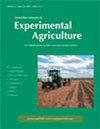Absence of persistent methane emission differences in three breeds of dairy cows
引用次数: 56
Abstract
In the present study, data from an experiment with 10 purebred Holstein, Simmental and Jersey cows each were analysed to test the assumption that there are genetically low methane-producing animals. Methane emission of cows offered forage ad libitum and some concentrate was measured for 3 days in open-circuit respiration chambers in weeks 8, 15, 23, 33 and 41 of lactation. Individual cow data were analysed in five different ways: (i) plotting the trend of methane per unit of dry matter intake (DMI) and milk yield over time; relating measured methane production to estimates derived from equations based on either; (ii) DMI or (iii) nutrient intake; (iv) relating residual feed intake (RFI) to methane emission; and (v) analysis of variance of cow × measurement interactions. The Holstein, Simmental and Jersey cows emitted on average 25, 25 and 26 g methane/kg DMI, respectively. There was no indication of individual cows with persistently low or high methane yield per kg DMI and per kg milk. Measured methane emissions differed from estimated values without a clear pattern, and the relationship between RFI and methane emission of the cows was weak. Finally, analysis of variance failed to show distinct patterns of methane per unit of DMI and milk for individual animals. The apparent lack of persistence of individual animal differences in methane yields suggests that genetic determination of this trait is of minor importance in dairy cows.三种奶牛的甲烷排放不存在持续差异
在目前的研究中,对10头纯种荷斯坦奶牛、西门塔尔奶牛和泽西奶牛的实验数据进行了分析,以验证存在基因上低甲烷排放动物的假设。于泌乳期第8、15、23、33和41周,在开式呼吸室中连续3 d测量奶牛自由饲喂饲料和部分精料的甲烷排放量。对奶牛个体数据进行了五种不同的分析:(i)绘制单位干物质摄入量(DMI)和产奶量随时间的变化趋势;将测量的甲烷产量与基于两者之一的方程得出的估计值联系起来;(ii) DMI或(iii)营养摄入量;(iv)将剩余采食量与甲烷排放联系起来;(v)奶牛与测量相互作用的方差分析。荷斯坦奶牛、西门塔尔奶牛和泽西奶牛的平均甲烷排放量分别为25、25和26 g /kg DMI。没有迹象表明个别奶牛的每公斤DMI和每公斤牛奶的甲烷产量持续低或高。实测甲烷排放量与估计值差异不明显,RFI与奶牛甲烷排放量的关系较弱。最后,方差分析未能显示出个体动物单位DMI和牛奶中甲烷含量的不同模式。甲烷产量的个体差异明显缺乏持久性,这表明这一性状的遗传决定对奶牛的重要性不大。
本文章由计算机程序翻译,如有差异,请以英文原文为准。
求助全文
约1分钟内获得全文
求助全文

 求助内容:
求助内容: 应助结果提醒方式:
应助结果提醒方式:


